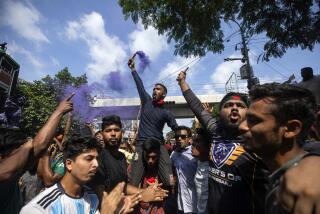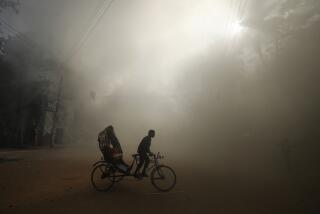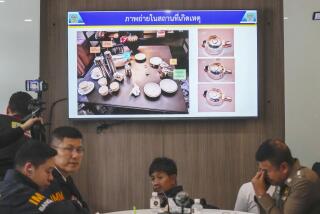Thailand violence claims two lives
BANGKOK, THAILAND — Some 4,000 anti-government protesters agreed early today to end a three-week siege of Thailand’s administrative capital after they were surrounded by government forces in downtown Bangkok, protest leaders announced.
The protesters were driven from positions around Bangkok by government forces in a day of bloody street battles on Monday.
After being encircled by some 6,000 troops at their base on the lawns of Government House, the office of the prime minister, the demonstrators agreed to call off their lengthy protests and began heading for home
At least two people were killed and nearly 100 injured across the Thai capital Monday as soldiers and neighborhood militias fought to dislodge the red-shirted protesters from their camp and from Bangkok’s famously congested alleyways.
The dead were members of a hastily formed militia that fought protesters and then retreated through the streets of Bangkok’s Nang Leong area.
The deaths follow days of protests against the government of Prime Minister Abhisit Vejjajiva by supporters of his archrival, Thaksin Shinawatra, a former prime minister now guiding and bankrolling the protesters from points unknown.
Protests turned violent after the government imposed a state of emergency and moved troops into the capital over the weekend.
“Security forces have brought back normalcy, except for Government House,” Abhisit said in televised speech late Monday. “The government will provide transportation for people wishing to leave the protest site.”
The protesters, members of the United Front for Democracy Against Dictatorship, or UDD, were gradually cut off from other pockets of demonstrators around the capital. The government also took over a key communications satellite used by the UDD to link with supporters in the provinces.
In places, downtown Bangkok had the look of a war zone: an abandoned public bus, choked with flames; patrolling Humvees mounted with .50-caliber guns; angry mobs answering tear-gas grenades with Molotov cocktails and homemade bombs.
Only four months ago, a Thaksin-aligned government was in power facing debilitating protests of its own.
Since Abhisit took power through a parliamentary vote in late 2008, his tenure has been plagued by a new wave of counter-protests.
Thaksin and his supporters say the current government came to power as a result of an elitist coup, their term for the protests, which included the occupation of Thailand’s main airport, that forced Abhisit’s predecessor, an ally of Thaksin, to step down.
Speaking via video link Sunday, Thaksin called on his supporters to overthrow the government and promised to return to lead what he calls a “people’s revolution.”
“I will come to Thailand to lead this protest myself,” he told the BBC on Monday night.
Thaksin, a former policeman and billionaire telecom tycoon who was educated in Texas, ridicules the 44-year-old Abhisit as too young to lead the country through tight economic times.
He says his ouster in a bloodless military coup in 2006 was the result of behind-the-scenes power-sharing among the powerful military establishment, Bangkok’s business community and the Privy Council, a body that advises Thailand’s revered King Bhumibol Adulyadej.
Thaksin’s, whose whereabouts are unknown, faces a two-year jail sentence in Thailand on corruption charges. His supporters claim he would win a national election if it was held today.
His critics claim he was an autocrat who reached power through vote-buying and intimidation.
Either way, he retains substantial support from Thailand’s rural poor.
In street battles Monday, 97 people were injured, four by gunshots, the Ministry of Public Health said.
Army regulars used automatic rifles and tear gas to dislodge protesters, who threw firebombs and set tires and buses on fire as they retreated. They set fire to the Ministry of Education with volleys of Molotov cocktails, and torched a car in front of the United Nations building, according to reports.
Withdrawing protesters were attacked by furious residents in at least two locations.
In a predominantly Muslim district near Nang Leong police station, gunshots and firebombs were exchanged and hand-to-hand fighting was seen deep inside narrow residential streets.
Residents said a mosque was firebombed.
According to a homeowner, the neighborhood houses a major electricity hub and fuel center, and locals were defending it against a takeover.
Mothers were seen dragging screaming infants out of the way as opposing mobs clashed with fists, sticks and makeshift weapons.
By late Monday afternoon, ad hoc militias had risen up against the protesters. In some places, they battled with small arms and homemade bombs from alley to alley. Smoke and tear gas filled the air.
The wail of ambulances and firetrucks, and the sound of distant gunfire and explosions echoed through the city.
“I heard bullets and bombs and ambulances. I woke up and saw the soldiers shoot a protester,” said shopkeeper Surapon Samwon, 51. “I am worried the ‘reds’ will burn the whole place.”
--
McDermid and Kaewsangthong are special correspondents.
More to Read
Sign up for Essential California
The most important California stories and recommendations in your inbox every morning.
You may occasionally receive promotional content from the Los Angeles Times.










